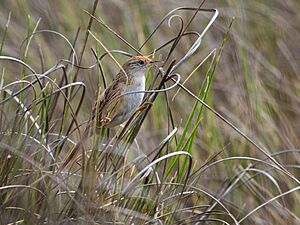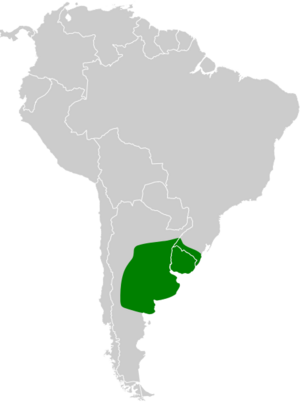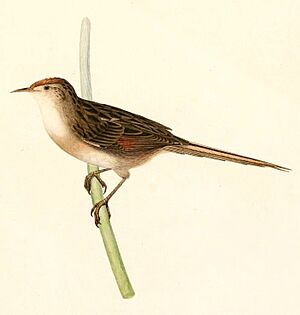Bay-capped wren-spinetail facts for kids
Quick facts for kids Bay-capped wren-spinetail |
|
|---|---|
 |
|
| Conservation status | |
| Scientific classification | |
| Genus: |
Spartonoica
|
| Species: |
maluroides
|
 |
|
The bay-capped wren-spinetail (Spartonoica maluroides) is a small bird that belongs to the ovenbird family called Furnariidae. You can find this bird in Argentina, Brazil, Paraguay, and Uruguay.
Contents
About Its Name and Family
The bay-capped wren-spinetail is special because it's the only bird in its group, called Spartonoica. It doesn't have any different types or subspecies.
This bird was first named Synallaxis maluroides. Later, it was put into another group called Asthenes. But since 1950, scientists have agreed it belongs in its own group, Spartonoica. Genetic studies show it's not closely related to Asthenes. Instead, it's more like the "cachalotes" birds from the Pseudoseisura group.
What It Looks Like
The bay-capped wren-spinetail is about 13 to 14.5 cm (5.1 to 5.7 in) long. It weighs around 10.5 g (0.37 oz), which is about the same as a few paper clips. Both male and female birds look alike.
Adult birds have a white stripe above their eyes. The rest of their face is sandy brown. The top of their head is a reddish-brown color. Their back is sandy brown to olive-brown. They have clear black stripes on their neck and upper back. Their wings are brown with a cinnamon color near the base of the flight feathers. Their tail is mostly brown and gets narrower at the end, with pointed feathers. The two middle tail feathers have some black.
Their belly is whitish. Their chest, sides, and flanks (the area between the ribs and hips) have a buff or cinnamon tint. Their eyes can be dull white, whitish, or pale blue. Their upper beak is dark, and their lower beak is whitish to pink with a dark tip. Their legs and feet are light tan. Birds living near the coast might be slightly different in size or color than those living inland, but they are very similar genetically.
Where It Lives
You can find the bay-capped wren-spinetail in southern Brazil. It also lives south through Uruguay and into northern Argentina, as far as Río Negro Province. Sometimes, it visits Paraguay when it's not breeding.
This bird likes to live in marshes. These are wet areas with reeds and sedges (grass-like plants). It can live in freshwater, salty water, or slightly salty water marshes. It lives from sea level up to about 900 m (3,000 ft) high.
How It Behaves
Moving Around
Scientists are still learning about how the bay-capped wren-spinetail moves. It seems to stay in one place most of the time. However, some birds have been seen as far north as Paraguay during the non-breeding season.
What It Eats
The bay-capped wren-spinetail eats small creatures without backbones. These are mostly insects and spiders. It usually looks for food alone. It picks its food from marsh grasses and sedges. There's some evidence that pairs nesting in salty marshes prefer to find food in freshwater marshes.
Making a Family
In Argentina, the bay-capped wren-spinetail lays eggs between September and February. These birds stay with one partner. Both the male and female birds help build the nest. They also take turns sitting on the eggs and feeding the baby birds.
Their nest is shaped like an open cup, which is unusual for ovenbirds. They build it from twigs and grass. The nest is placed low to the ground, hidden deep inside the marsh plants. A female usually lays two to four eggs. The eggs hatch after about 13 days. The young birds leave the nest when they are 11 to 14 days old.
Its Song
The main song of the bay-capped wren-spinetail sounds like a "grasshopper-like buzz." It's long and doesn't have a clear tune, rising and falling. It also makes other sounds, but scientists don't know what those sounds mean yet.
Its Future
The IUCN (International Union for Conservation of Nature) first thought the bay-capped wren-spinetail was "Near Threatened." This meant it might be at risk soon. But in 2022, they changed its status to "Least Concern." This means it's not in immediate danger.
Even though it has a large area where it lives, the total number of these birds is unknown. However, it's believed that their numbers are going down. This bird needs wetlands to live. So, it's threatened when marshes are drained or dried out by certain tree farms, especially in parts of Argentina. Other threats include too many cows eating the grass and new wind farms being built.



